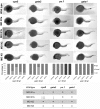The zebrafish reveals dependence of the mast cell lineage on Notch signaling in vivo
- PMID: 22368273
- PMCID: PMC3375148
- DOI: 10.1182/blood-2011-10-385989
The zebrafish reveals dependence of the mast cell lineage on Notch signaling in vivo
Abstract
We used the opportunities afforded by the zebrafish to determine upstream pathways regulating mast cell development in vivo and identify their cellular origin. Colocalization studies demonstrated zebrafish notch receptor expression in cells expressing carboxypeptidase A5 (cpa5), a zebrafish mast cell-specific marker. Inhibition of the Notch pathway resulted in decreased cpa5 expression in mindbomb mutants and wild-type embryos treated with the γ-secretase inhibitor, Compound E. A series of morpholino knockdown studies specifically identified notch1b and gata2 as the critical factors regulating mast cell fate. Moreover, hsp70::GAL4;UAS::nicd1a transgenic embryos overexpressing an activated form of notch1, nicd1a, displayed increased cpa5, gata2, and pu.1 expression. This increase in cpa5 expression could be reversed and reduced below baseline levels in a dose-dependent manner using Compound E. Finally, evidence that cpa5 expression colocalizes with lmo2 in the absence of hematopoietic stem cells revealed that definitive mast cells initially delineate from erythromyeloid progenitors. These studies identify a master role for Notch signaling in vertebrate mast cell development and establish developmental origins of this lineage. Moreover, these findings postulate targeting the Notch pathway as a therapeutic strategy in mast cell diseases.
Figures







Similar articles
-
Zebrafish Her8a is activated by Su(H)-dependent Notch signaling and is essential for the inhibition of neurogenesis.PLoS One. 2011 Apr 26;6(4):e19394. doi: 10.1371/journal.pone.0019394. PLoS One. 2011. PMID: 21541299 Free PMC article.
-
Notch signaling regulates neural precursor allocation and binary neuronal fate decisions in zebrafish.Development. 2007 May;134(10):1911-20. doi: 10.1242/dev.001602. Epub 2007 Apr 18. Development. 2007. PMID: 17442701
-
Notch signaling controls the differentiation of transporting epithelia and multiciliated cells in the zebrafish pronephros.Development. 2007 Mar;134(6):1111-22. doi: 10.1242/dev.02806. Epub 2007 Feb 7. Development. 2007. PMID: 17287248
-
Zebrafish: A Suitable Tool for the Study of Cell Signaling in Bone.Cells. 2020 Aug 17;9(8):1911. doi: 10.3390/cells9081911. Cells. 2020. PMID: 32824602 Free PMC article. Review.
-
Genetic mechanisms of multiciliated cell development: from fate choice to differentiation in zebrafish and other models.FEBS J. 2024 Oct;291(19):4159-4192. doi: 10.1111/febs.17012. Epub 2023 Dec 1. FEBS J. 2024. PMID: 37997009 Review.
Cited by
-
Analysis of incidental findings in Qatar genome participants reveals novel functional variants in LMNA and DSP.Hum Mol Genet. 2022 Aug 23;31(16):2796-2809. doi: 10.1093/hmg/ddac073. Hum Mol Genet. 2022. PMID: 35348702 Free PMC article.
-
Metal transporter Slc30a1 controls pharyngeal neural crest differentiation via the zinc-Snai2-Jag1 cascade.MedComm (2020). 2021 Sep 27;2(4):778-797. doi: 10.1002/mco2.91. eCollection 2021 Dec. MedComm (2020). 2021. PMID: 34977877 Free PMC article.
-
PGAP3 Associated with Hyperphosphatasia with Mental Retardation Plays a Novel Role in Brain Morphogenesis and Neuronal Wiring at Early Development.Cells. 2020 Jul 27;9(8):1782. doi: 10.3390/cells9081782. Cells. 2020. PMID: 32726939 Free PMC article.
-
Increased Expression of SETD7 Promotes Cell Proliferation by Regulating Cell Cycle and Indicates Poor Prognosis in Hepatocellular Carcinoma.PLoS One. 2016 May 16;11(5):e0154939. doi: 10.1371/journal.pone.0154939. eCollection 2016. PLoS One. 2016. PMID: 27183310 Free PMC article.
-
Transcriptome Profile Identifies Actin as an Essential Regulator of Cardiac Myosin Binding Protein C3 Hypertrophic Cardiomyopathy in a Zebrafish Model.Int J Mol Sci. 2022 Aug 9;23(16):8840. doi: 10.3390/ijms23168840. Int J Mol Sci. 2022. PMID: 36012114 Free PMC article.
References
-
- Galli SJ, Nakae S, Tsai M. Mast cells in the development of adaptive immune responses. Nat Immunol. 2005;6(2):135–142. - PubMed
-
- Ribatti D, Molica S, Vacca A, et al. Tryptase-positive mast cells correlate positively with bone marrow angiogenesis in B-cell chronic lymphocytic leukemia. Leukemia. 2003;17(7):1428–1430. - PubMed
-
- Ribatti D, Crivellato E, Roccaro AM, Ria R, Vacca A. Mast cell contribution to angiogenesis related to tumour progression. Clin Exp Allergy. 2004;34(11):1660–1664. - PubMed
-
- Berman J, Hsu K, Look AT. Zebrafish as a model organism for blood diseases. Br J Haematol. 2003;123(4):568–576. - PubMed
-
- Bahary N, Zon LI. Use of the zebrafish (Danio rerio) to define hematopoiesis. Stem Cells. 1998;16(2):89–98. - PubMed
Publication types
MeSH terms
Substances
Grants and funding
LinkOut - more resources
Full Text Sources
Molecular Biology Databases

